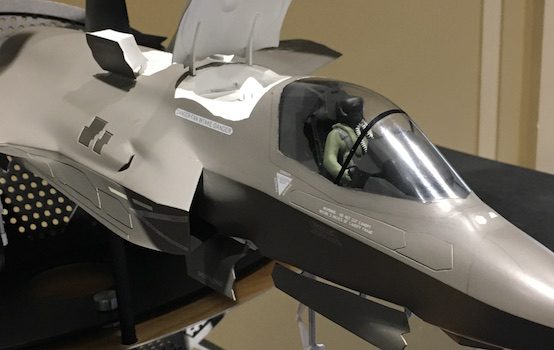Trigger-Happy Defense Earmarking Leads to Even More F-35s

Well into the second year of the Trump administration, “draining the swamp” is more of a hapless zigzag than a charge against Washington’s sacred cows.
Case in point: the earmarking process. Despite a 2011 ban on congressional earmarking, lawmakers have found ways to bake “inducements” into massive defense and infrastructure bills. Tallying and tabulating the earmarks found in the fiscal year (FY) 2019 Defense Appropriations Bill, the Taxpayers Protection Alliance (TPA) found 679 earmarks totaling $19.3 billion. These earmarks fuel unnecessary and unaccountable programs that harm taxpayers and service members alike.
One large winner from the still-widespread earmarking process is the F-35 aircraft program, slated to run taxpayers an estimated $1.5 trillion due to the combined costs of construction, fuel, and maintenance over a 20-year time frame. The cost overruns are infamous, with a 7 percent jump in price over the past year alone. The program’s executive officer, Mathias W. Winter, claimed in a hearing that, despite poor management decisions over the past 20 years, the situation has improved since 2011’s clock reset and the F-35 program has become more affordable and reliable. Yet average F-35 costs have more than doubled since the program’s inception in 2001. Taxpayers have seen the per-aircraft cost rise from $62.2 million to $158.4 million, and it would have been even higher if the Pentagon hadn’t taken well-documented shortcuts in the construction process. Despite these warnings and cost overruns, however, the House added $740 million for eight additional F-35s in the current spending bill.
A June 2018 report from the Government Accountability Office noted that F-35 aircraft had 111 deficiencies that “may cause death, severe injury, or severe occupational illness; may cause loss or major damage to a weapon system; critically restricts the combat readiness capabilities of the using organization; or result in a production line stoppage.” An additional 855 deficiencies could “impede or constrain successful mission accomplishment.”
Yet rather than fixing these potentially fatal design flaws, Pentagon documents obtained by the Project on Government Oversight (POGO) show that planners are eager to patch over these flaws in order to move full speed ahead. Take, for instance, the failure of the emergency squawk to “automatically initiate upon ejection.” Despite the obvious threat to service personnel, the Deficiency Review Board moved to “change status to no plan to correct….”
In response to these deficiencies and mission-critical shortcomings, the Pentagon could have instead committed to capping off the program and dedicating remaining resources to ensuring program safety and effectiveness. But some members of Congress had other ideas. House Armed Services Committee subcommittee chairman Mike Turner suggested that ramping up production even further could lower per-unit costs, despite increasing the total program cost to taxpayers. For the subcommittee chairman, boosting production would be “bringing home the bacon” to his constituents in the Dayton area, where multiple F-35 suppliers are located. Pork-barrel politics aside, if the plane “doesn’t work,” how will buying more make them better? Sure, per-unit costs will tend to be low (by 2018 standards) with a bulk purchase, but amping up total program costs from $1.5 trillion to more than $2 trillion shows a reckless disregard for taxpayer money and guarantees continued designed woes.
The F-35 is but one of countless programs soaring in costs yet lacking any sort of accountability. TPA also found, for instance, that appropriators allocated $950 million for two additional Littoral Combat Ships (LCS) this year, on top of the Navy’s $646 million request for just one additional ship. Lacking in these requests was any justification for the program increase, given the disappointing results delivered by the program thus far. In a review conducted between 2016 and 2018, the Pentagon found significant LCS shortcomings, including little backup capability for vital system functions and nil missile self-defense functions. In fact, there’s a significant chance that “a single hit will result in loss of propulsion, combat capability, and the ability to control damage and restore system operation.”
Yet with the rampant cost escalation that has plagued the program since its inception in 2005, one could be forgiven for thinking that LCS ships have Volvo-style safety features. LCS vessels now cost more than $600 million each, nearly triple the figure that was initially slated back in 2005. The late Senator John McCain rightly pointed out that “the littoral combat ship, or LCS, is an unfortunate yet all too common example of defense acquisition gone awry.”
As long as programs such as the F-35 and LCS are beholden to trigger-happy appropriators focused more on winning reelection than eliminating program waste, costs will continue to skyrocket. Congress can take a first bold step by strengthening the earmark ban on the books, rather than eliminating it as some have suggested.
Lawmakers must also hold the Pentagon accountable for these ballistic boondoggles, by tying funding more closely to program capabilities and cost overruns. Until officials—both on Capitol Hill and in the Pentagon—start applying pressure to faulty programs, service members and taxpayers will continue to be in the line of fire.
Ross Marchand is the director of policy for the Taxpayers Protection Alliance.
Comments